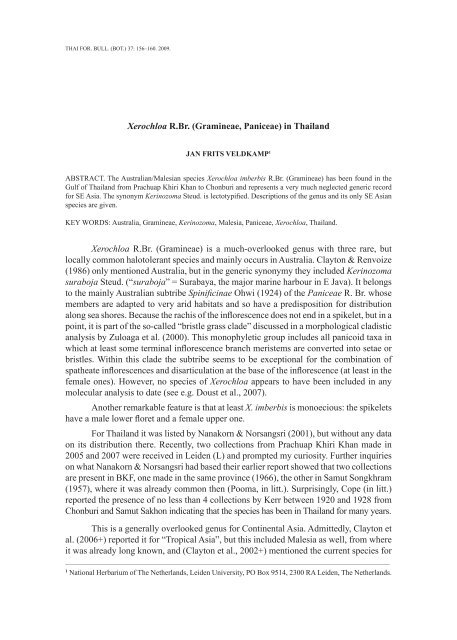Create successful ePaper yourself
Turn your PDF publications into a flip-book with our unique Google optimized e-Paper software.
<strong>THAI</strong> FOR. BULL. (BOT.) 37: 156–160. 2009.<br />
Xerochloa R.Br. (Gramineae, Paniceae) in Thailand<br />
Jan FRiTs VELDKaMP 1<br />
ABSTRACT. The Australian/Malesian species Xerochloa imberbis R.Br. (Gramineae) has been found in the<br />
Gulf of Thailand from Prachuap Khiri Khan to Chonburi and represents a very much neglected generic record<br />
for SE Asia. The synonym Kerinozoma Steud. is lectotypified. Descriptions of the genus and its only SE Asian<br />
species are given.<br />
KEY WORDS: Australia, Gramineae, Kerinozoma, Malesia, Paniceae, Xerochloa, Thailand.<br />
Xerochloa R.Br. (Gramineae) is a much-overlooked genus with three rare, but<br />
locally common halotolerant species and mainly occurs in Australia. Clayton & Renvoize<br />
(1986) only mentioned Australia, but in the generic synonymy they included Kerinozoma<br />
suraboja Steud. (“suraboja” = Surabaya, the major marine harbour in E Java). It belongs<br />
to the mainly Australian subtribe Spinificinae Ohwi (1924) of the Paniceae R. Br. whose<br />
members are adapted to very arid habitats and so have a predisposition for distribution<br />
along sea shores. Because the rachis of the inflorescence does not end in a spikelet, but in a<br />
point, it is part of the so-called “bristle grass clade” discussed in a morphological cladistic<br />
analysis by Zuloaga et al. (2000). This monophyletic group includes all panicoid taxa in<br />
which at least some terminal inflorescence branch meristems are converted into setae or<br />
bristles. Within this clade the subtribe seems to be exceptional for the combination of<br />
spatheate inflorescences and disarticulation at the base of the inflorescence (at least in the<br />
female ones). However, no species of Xerochloa appears to have been included in any<br />
molecular analysis to date (see e.g. Doust et al., 2007).<br />
Another remarkable feature is that at least X. imberbis is monoecious: the spikelets<br />
have a male lower floret and a female upper one.<br />
For Thailand it was listed by Nanakorn & Norsangsri (2001), but without any data<br />
on its distribution there. Recently, two collections from Prachuap Khiri Khan made in<br />
2005 and 2007 were received in Leiden (L) and prompted my curiosity. Further inquiries<br />
on what Nanakorn & Norsangsri had based their earlier report showed that two collections<br />
are present in BKF, one made in the same province (1966), the other in Samut Songkhram<br />
(1957), where it was already common then (Pooma, in litt.). Surprisingly, Cope (in litt.)<br />
reported the presence of no less than 4 collections by Kerr between 1920 and 1928 from<br />
Chonburi and Samut Sakhon indicating that the species has been in Thailand for many years.<br />
This is a generally overlooked genus for Continental Asia. Admittedly, Clayton et<br />
al. (2006+) reported it for “Tropical Asia”, but this included Malesia as well, from where<br />
it was already long known, and (Clayton et al., 2002+) mentioned the current species for<br />
_______________________________________________________________________________________________________________________________________________________<br />
1 National Herbarium of The Netherlands, Leiden University, PO Box 9514, 2300 RA Leiden, The Netherlands.
















